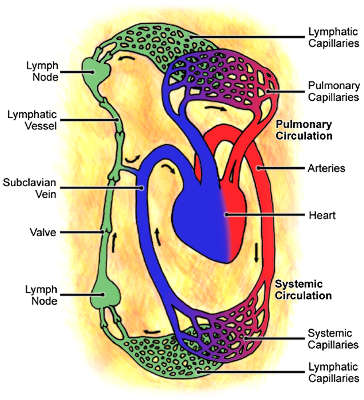Every once in a while I find a medical illustration that does a really good job visually explaining how something works. This is one of them. And occasionally they inspire me; motivating me to study far beyond my original search for answers. With this one there are a lot of potential learning and teaching points whether the author or artist intended any additional meaning or potential in their efforts.
I like this one…8). I’ve been intimately aware of my circulatory system as long as I’ve heard my heart beat. But I didn’t really understand the significance of that extra green part. The lymphatic system. Of course I had heard of it, but I didn’t fully understand the significance of it and its proper functionality for my wellbeing. That is until my body decided to teach me a more excellent way of taking care of business. Handling cellular life…8). More on that later.
An adult circulatory system, arteries and veins, transports about 6,000-7,500 liters of plasma and its companions, red and white blood cells.
The lymphatic system helps maintain fluid balance. It returns excess tissue fluid, or blood plasma(same thing; different place) along with proteins from our soft tissues that cannot be returned through the blood vessels.
Blood Plasma = Tissue Fluid = Lymphatic Fluid
The tissue fluid found in the tissue spaces and cavities, in the tiny spaces surrounding cells, known as the interstitial spaces, these are reached by the smallest blood and lymph capillaries.
Around 90 percent of the plasma that reaches our soft tissues from the arterial blood capillaries is returned by the venous capillaries and back along veins. The remaining 10 percent remains in the soft tissues and is eventually drained back by the lymphatics.
Each day, around 2-3 liters is returned. This fluid includes waste proteins that are too large to be transported via the blood vessels. As that process is taking place these proteins are continually denatured along the way until they reenter general circulation at the end of its journey just above our heart where it begins the journey all over again.
If this system failed to function properly the toxic burden on our body would be too great and we we would die within a day. Without this third leg of our circulatory system draining its fluids excess waste or cellular debris our soft tissues would swell. Blood volume would decrease because that fluid is our blood plasma, just outside the arteries and veins and blood pressure would increase until the skin, kidneys, liver and lungs become overburdened resulting in acute failure.
Scribe(author) – Michael J. Loomis | Editor at Chew Digest
